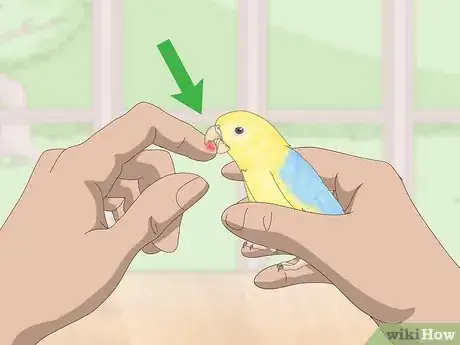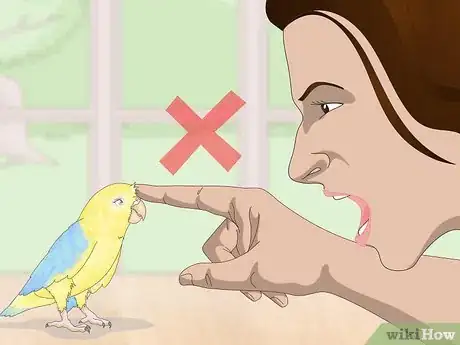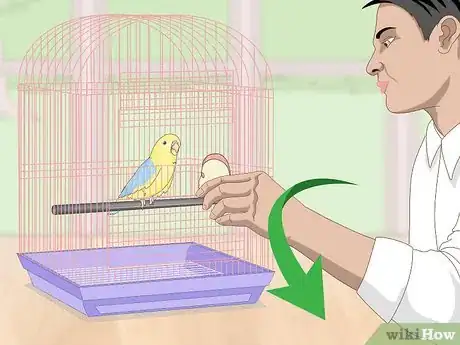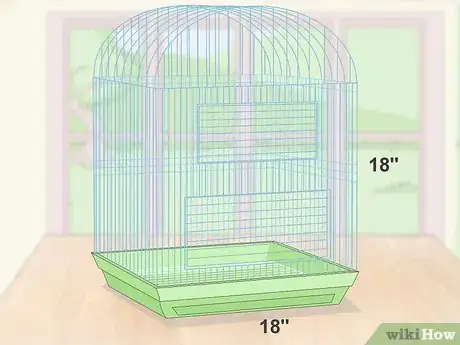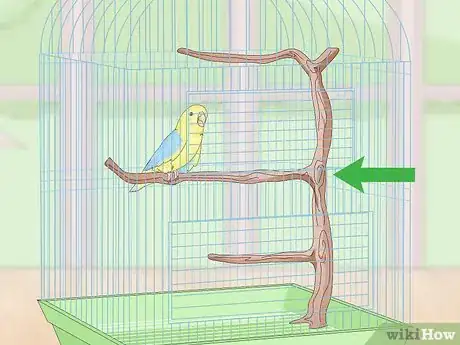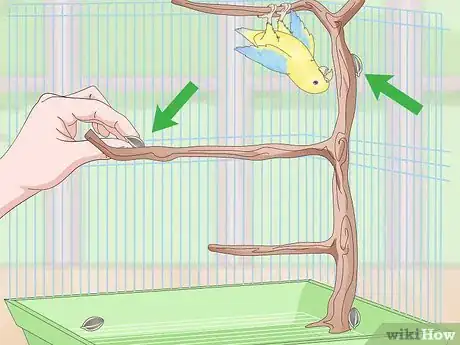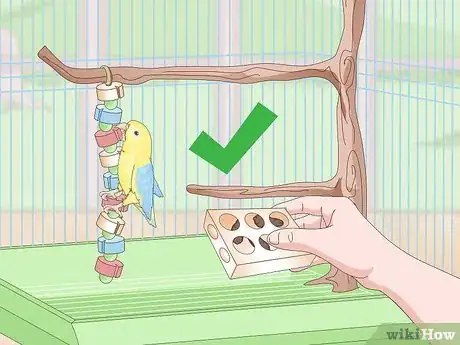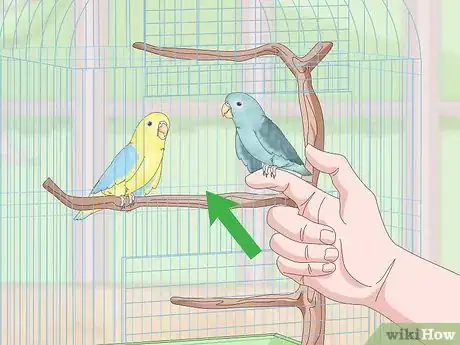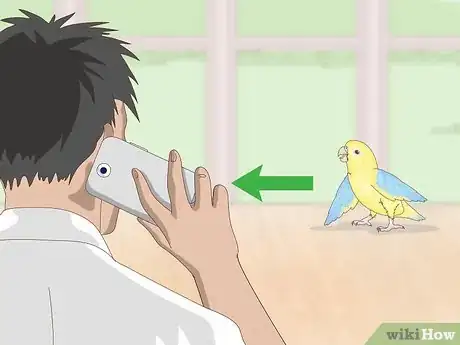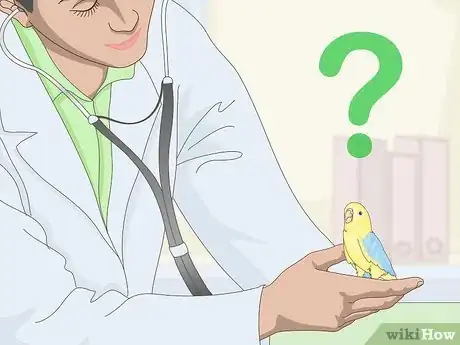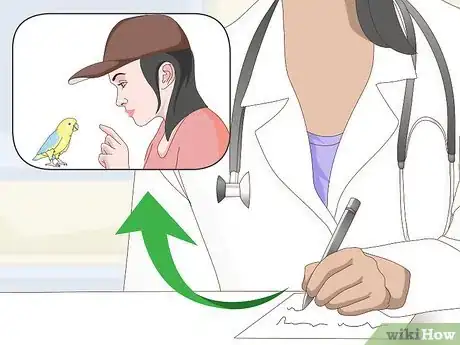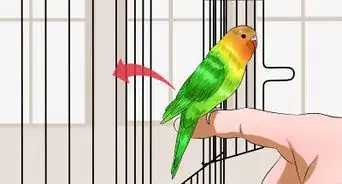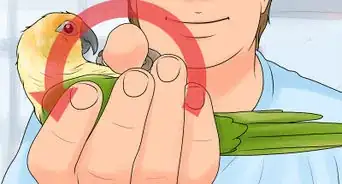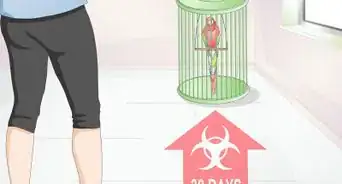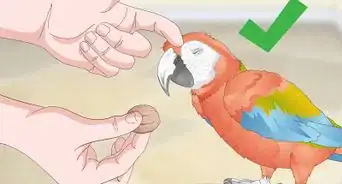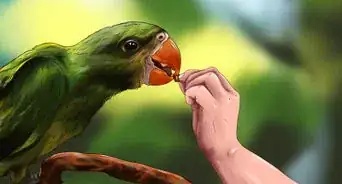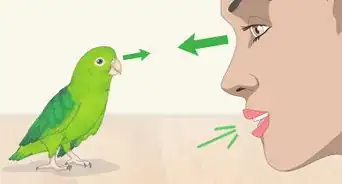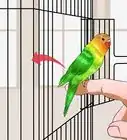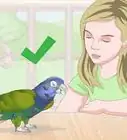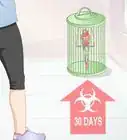This article was co-authored by Deanne Pawlisch, CVT, MA. Deanne Pawlisch is a Certified Veterinary Technician, who does corporate training for veterinary practices and has taught at the NAVTA-approved Veterinary Assistant Program at the Harper College in Illinois and in 2011 was elected to the board of the Veterinary Emergency and Critical Care Foundation. Deanne has been a Board Member of the Veterinary Emergency and Critical Care Foundation in San Antonio, Texas since 2011. She holds a BS in Anthropology from Loyola University and an MA in Anthropology from Northern Illinois University.
There are 10 references cited in this article, which can be found at the bottom of the page.
This article has been viewed 17,195 times.
Despite their tiny size, parrotlets are feisty, high energy birds with big personalities. If your parrotlet is aggressive, reinforcement and desensitization training can help you correct unwanted behaviors. Enriching its habitat can also help it stay busy and burn off energy. Sudden behavioral changes could be signs of illness, so consult a vet if you're concerned about your pet's health.
Steps
Correcting Aggressive Behavior
-
1Identify when your parrotlet is most aggressive. Aggression could be due to a number of causes, so observation is the first step to correcting the behavior. Note if your parrotlet is aggressive when you touch it or in response to specific sights and sounds.[1]
- If your pet bites or lunges when you touch it, you might be handling it too roughly. Give it some space, offer treats to make it more comfortable with you, and work on being more gentle when you handle it.[2]
- If it acts aggressively in response to scary triggers, like when you run the vacuum or have a visitor, desensitization training might be your best option.
-
2Don't yell or use physical punishment. If you respond improperly to unwanted behaviors, you could accidentally reinforce them. Using force to punish your parrotlet will only encourage further aggression.[3] Yelling won't work either, as your bird will enjoy the attention.[4]Advertisement
-
3Reward acceptable behaviors and ignore unwanted behaviors. When you see your bird start to bite or lunge, give it a toy so it'll attack the object instead of your hand. Offer treats and verbal praise when it plays with toys to let it know it's doing a good job. If it does charge at you and you don't have a toy handy, you might place the bird on the ground where it will feel less secure. Don't give it any further reaction.[5]
-
4Correct fearful biting with desensitization training. Expose your parrotlet to the object or situation that scares it in small amounts, and use treats to help it overcome its fear.[6] For example, if it's fearful and aggressive around new people, visitors should place a high value treat in the cage, then walk away without lingering.[7]
- Have them drop a few more treats in the cage during their visit. Over time, the bird should associate visitors with positivity and become more comfortable with your guests.
-
5Train your bird to step up and down. "Step up" and "Step down" are basic commands that can help establish you as the alpha bird. Hold your finger at the level of the parrotlet's chest and say “Step up!” When it steps up, offer a treat and verbal praise immediately.[8]
Enriching Its Habitat
-
1Make sure its enclosure is large enough. Parrotlets are high energy birds and require a lot of space for their size. The minimum cage size recommended for one parrotlet is 18 by 18 inches (46 by 46 centimeters). Getting a larger cage or providing more out of cage time could help your feisty parrotlet burn off more energy.[11]
- For parrotlets, width is more important than height, so consider getting a wider cage with more room for it to play.
-
2Provide multiple perches that mimic natural branches. Simple, ninety-degree perches don't provide much stimulation for birds. Instead, provide multiple natural wood perches of different thicknesses and kinds, such as manzanita or eucalyptus branches. You can find natural perches online or at your local pet supply store.[12]
- Having a variety of perches won't just give your bird more stimulation. They'll also help it develop healthy feet and prevent pododermatitis.
- Perches that swing are also great, as they provide physical exercise and mental stimulation.
-
3Hide treats to encourage foraging. In the wild, birds spend lots of time foraging for food. Captive birds can get bored if they don't have any reason to explore their enclosure, so hide treats throughout the cage to encourage foraging.[13]
- Try hiding treats under piles of paper or cardboard. Place a container of seeds covered with pebbles in the enclosure. Food dispensing toys are also great for encouraging foraging.
-
4Provide a variety of toys to keep your bird busy. Make sure it has a steady rotation of chew toys and puzzles to keep it entertained while you're away from home. Provide toys with varied colors and textures, and make sure they're durable enough for your parrotlet's strong beak.[14]
- Rotate toys every one to two weeks so it doesn't get bored with them.
- Choose more durable toys marked for cockatiels and conures instead those labeled for budgies and finches.[15]
-
5Consider getting your parrotlet a playmate. Parrotlets are social birds and are often kept in captivity in pairs. If you do keep two birds, it's best to have them sleep in separate cages. Even if you have a pair of parrotlets, do your best to spend lots of quality time with them to reinforce your bond.[16]
- Parrotlets mate for life and will bond strongly to a partner. For this reason, some people think that parrotlets in pairs don't make good pets. It really depends on what type of relationship you want with the birds, however.
- You might not develop as close a bond to parrotlets in pairs. However, this may be better for the birds if you are not around often or aren't able to spend much time with them.
Consulting Professionals
-
1Schedule a checkup if your bird's behavior changes suddenly. Sudden changes in behavior could be a sign of illness. If your typically well-behaved bird unexpectedly starts behaving aggressively, bring it to the vet for a checkup.[17]
- Search online to find an avian vet if you don't already have one. You can use the search tool on the website of the Association of Avian Veterinarians: https://www.aav.org/default.aspx.
-
2Ask the vet if your bird might be hormonal. Aggressive hormonal mating behavior is normal. If you have trouble dealing it with, ask the vet if they recommend drug therapy to reduce the spike in hormones.[18]
- If your bird is hormonal, try moving its cage and decreasing light levels. Swap high-calorie treats for fresh fruits and veggies, and avoid handling it too much.
-
3Get a referral to a certified trainer if necessary. If, despite your best efforts, you're unable to curb your bird's aggression, a certified trainer or behaviorist might be able to help. Ask your avian vet for a referral or search the website of the International Association of Animal Behavior Consultants: https://iaabc.org/consultants.
- Parrotlets are naturally feisty, so keep in mind you might just have to accept your pet's high energy.
References
- ↑ http://www.peteducation.com/article.cfm?c=15+1795&aid=1515
- ↑ https://www.beautyofbirds.com/biting.html
- ↑ https://www.beautyofbirds.com/breakingparrots.html
- ↑ http://www.peteducation.com/article.cfm?c=15+1795&aid=1515
- ↑ http://animals.mom.me/keep-parrotlets-biting-11457.html
- ↑ https://www.beautyofbirds.com/breakingparrots.html
- ↑ https://www.beautyofbirds.com/biting.html
- ↑ http://www.peteducation.com/article.cfm?c=15+1795&aid=1515
- ↑ https://www.beautyofbirds.com/biting.html
- ↑ https://www.beautyofbirds.com/parrotletsinfo.htm
- ↑ https://www.animalhumanesociety.org/adoption/parrotlet-care
- ↑ https://www.animalhumanesociety.org/adoption/parrotlet-care
- ↑ https://www.beautyofbirds.com/foraging.html
- ↑ http://www.petuniversity.com/birds/parrots-and-parakeets/parrotlets.htm
- ↑ https://www.animalhumanesociety.org/adoption/parrotlet-care
- ↑ https://www.beautyofbirds.com/parrotletsinfo.htm
- ↑ http://www.peteducation.com/article.cfm?c=15+1829&aid=2606
- ↑ https://www.beautyofbirds.com/sexualbehaviorinbirds.html
About This Article
If your parrotlet is being feisty and aggressive, correct its behavior by giving it a toy to attack if you see it about to bite or lunge. When it plays with its toys, give it plenty of treats and praise so it knows that it's doing a good job. Never yell or physically punish your bird for biting, because this can actually have to opposite effect because it might enjoy the attention and attack you more. If your bird is attacking out of fear, try desensitizing it to the object. Show the object to your parrotlet in small amounts and give it treats to help overcome its fear. For example, if it’s afraid of new people, have a visitor place a treat in the cage and walk away without lingering. For more tips from our Veterinary co-author, like how to find a certified trainer to help you out, read on!
